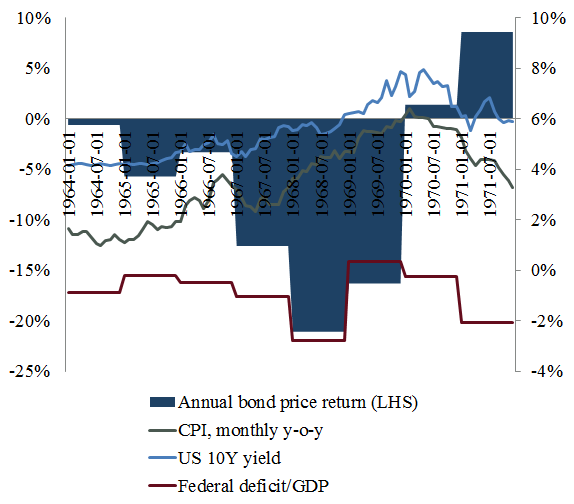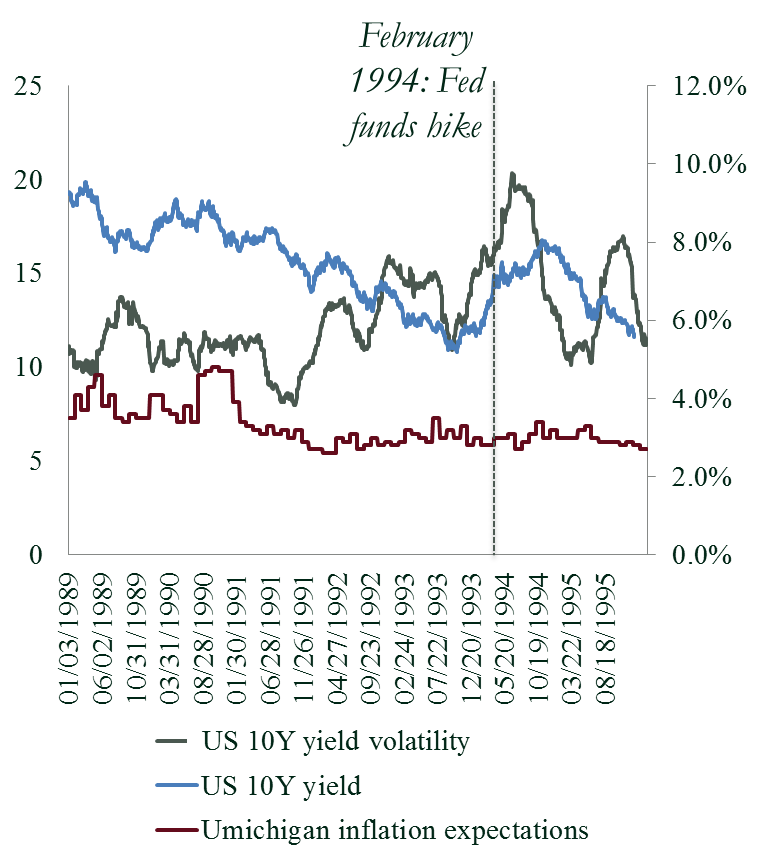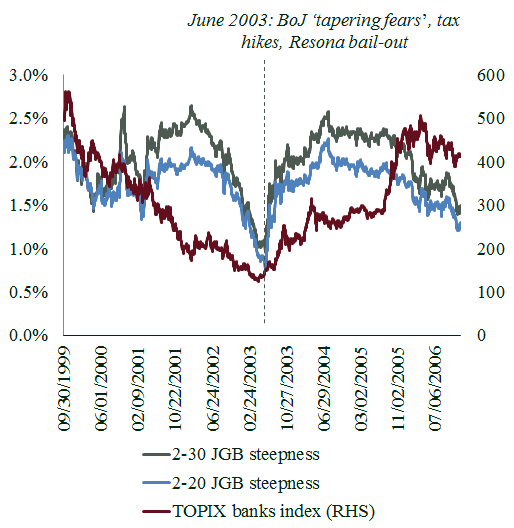First it was Goldman Sachs, which accurately warned last summer that a sharp spike in interest rates would lead to trillions in bond market losses, as observed over the past two months after the Trump election. Then it was Ray Dalio’s turn to warn NY Fed staffers that “it would only take a 100 basis point rise in Treasury bond yields to trigger the worst price decline in bonds since the 1981 bond market crash.” Now, it’s the turn of the Bank of England, which writes in its blog, Bank Underground, that once the latest bond market bubble bursts, “it leave investors worse off than the 1994 ‘bond massacre’,” when global bonds suffered the biggest annual loss on record.
The blog post author, Paul Schmelzing, a PhD candidate at Harvard University and a visiting scholar at the Bank of England, has little cheer for bond bulls, and writes that “as rates reached their lowest level ever in 2016, investors rather worried about the “biggest bond market bubble in history” coming to a violent end. The sharp sell-off in global bonds following the US election seems to confirm their fears. Looking back over eight centuries of data, I find that the 2016 bull market was indeed one of the largest ever recorded. History suggests this reversal will be driven by inflation fundamentals, and leave investors worse off than the 1994 “bond massacre”.
In his report, Schmelzing divided modern-day bond bear markets into three major types: “the inflation reversal” of 1967-1971, the “sharp reversal” of 1994, and Japan’s “VaR Shock” in 2003. He focuses on the 1994 reversal period, when the BofA Government Bond Index tumbled 3.1% in its worst-ever annual loss as Alan Greenspan surprised investors by almost doubling the benchmark rate. Treasury 10-year yields surged from 5.6 percent in January to 8 percent in November.

Fast forward to today, when he says that a :”pessimistic reader could certainly identify gloomy ingredients for the “perfect storm”: the potential for a painful steepening of bond curves, after a sustained flattening as in 2003, coupled with monetary tightening; and a multi-year period of sustained losses due to a structural return of inflation as in 1967.” As Bloomberg reminds us, last quarter was the worst for government bonds since 1987. It could get far worse, because while duration risk in 1994 was modest, it has never been greater than it is right now.

The implications: “By historical standards, this implies sustained double-digit losses on bond holdings, subpar growth in developed markets, and balance sheet risks for banking systems with a large home bias.”
Which, judging by the near all time highs in the S&P, would have no impact on stocks.
* * *
Below is his full post, courtesy of the Bank Underground blog
Venetians, Volcker and Value-at-Risk: 8 centuries of bond market reversals
Paul Schmelzing is a visiting scholar at the Bank from Harvard University, where he concentrates on 20th century financial history. In this guest post, he looks at the current bond market through the lens of nearly 800 years of economic history.
The economist Eugen von Böhm-Bawerk once opined that “the cultural level of a nation is mirrored by its interest rate: the higher a people’s intelligence and moral strength, the lower the rate of interest”. But as rates reached their lowest level ever in 2016, investors rather worried about the “biggest bond market bubble in history” coming to a violent end. The sharp sell-off in global bonds following the US election seems to confirm their fears. Looking back over eight centuries of data, I find that the 2016 bull market was indeed one of the largest ever recorded. History suggests this reversal will be driven by inflation fundamentals, and leave investors worse off than the 1994 “bond massacre”.
Bond “bull markets” since 1285
Chart 1: The Global risk free rate since 1285

As a contemporary of fin-de-siècle Vienna, Böhm-Bawerk witnessed a period of unprecedented internationalization, deepening trade relations, and technological innovation – associated with the parallel financial phenomena of the expansion of London-based merchant banks, and the growth in global capital mobility(triggering the heyday of the “cash nexus”). At this point, yields on the global “risk free bond” – then British consols – had fallen to an all-time low of 2.48% in 1898 (Chart 1). But not least his own enthusiasm should prove short-lived: soon after his writing, rates entered what Richard Sylla and Sidney Homer later defined as the “first bear bond market”.
Indeed, judging purely by historical precedent, at 36 years, the current bond bull market had been stretched. As chart 2 shows, over 800 years only two previous episodes – the rally at the height of Venetian commercial dominance in the 15th century, and the century following the Peace of Cateau-Cambrésis in 1559 – recorded longer continued risk-free rate compressions. The same is true if we measure the period by average decline in yields per annum, from peak to trough. With 33 bps, only the rallies following the War of the Spanish Succession, and the election of Charles V as Holy Roman Emperor surpass the bond performance since Paul Volcker’s “war on inflation”.
Chart 2: Length and size of bull markets since 1285

Modern bear shock markets, 1925-2016
It thus appears timely to ask about the characteristics of bear bond markets. Since Homer and Sylla’s first bear market, on our count the United States (the current issuer of the global risk-free asset) experienced 12 modern “bond shock” years, during which selloff dynamics cost long-term sovereign bond creditors more than 15% in real price terms.
Aggregating these bear markets (chart 3), we find that, at 6.1% CPI year-on-year on average, “bond shock years” record inflation levels almost double the long-term trend, at 3.1%. Global growth equally is below average, though not in recession territory. Interestingly, during bond bear markets, US federal deficits, with 2.3% of GDP, actually fall slightly below the post-1945 average track record of 2.9%. An increase in the supply of bonds, therefore, seems not decisive to the weakening in price levels.
Chart 3: Macroeconomic outcomes in bear markets

Bond turbulence, however, has traditionally struck investors in different shapes – especially since the time of Homer/Sylla’s first bear market. Below we present three types of modern bear bond case studies to illustrate that – while historically inflation acceleration has been a solid predictor of sharp bond selloffs – some prominent episodes appear less correlated with fundamentals, and can inflict similar levels of losses.
Type 1: The inflation reversal, 1967-1971
The “inflation reversal” leaves bondholders particularly bruised, and is most clearly associated with fundamentals: namely a sharp turnaround in realized consumer price inflation (CPI). This scenario correctly weighs on the minds of today’s reflationists. US bonds lost 36% in real price terms during 1965-1970, slightly outstripping losses during the 20th century’s first bear market (Chart 4). Annual CPI more than tripled in the same timeframe, from 1.6%, to 5.9%. Looser fiscal policies seem to have played only a secondary role in the 1965-70 bond sell-off, though the Vietnam War put some unexpected pressure on the federal budget. The deficit widened from just 0.2% in 1965, to 2.8% three years later – but USTs continued to decline when public finances swung back into positive territory.
Chart 4: The bear market of 1967-71

Type 2: The Sharp Reversal, 1994
The 1994 “bond massacre” has attracted particular attention of late, and represents a second type of reversal, characterized by steep, but short-lived turbulence that is associated more with financial sector leverage and exogenous positioning – rather than macro fundamentals.
After bottoming in the autumn of 1993, US bond market yields started ascending quickly, even amid discount rates on a 30-year low. A rollercoaster performance followed, which saw bond volatility surge to levels not seen since the Volcker inflation fight. However, US bonds were firmly back in bull territory by 1995, adding 18.1% in prices after inflation.
Neither inflation expectations – which peaked at an unexciting 3.4%– nor fiscal policies, which remained on the steady Clinton consolidation path, offer satisfactory explanations for the rout. Though journalistic accounts link the sell-off with the Fed’s February 1994 decision to raise short-term rates, closer investigations suggest a loose correlation at best. As the data proves, volatility in US 10 year bonds started rising in Q3-1993, while official discount rates were only raised in May 1994 – at a time when volatility had almost peaked already (Chart 5).
Chart 5: The “Bond Massacre” of 1994

Evidence from the financial sector rather suggests that the dramatic increase in leveraged bond positions by both US hedge funds and mundane money managers set in motion self-reinforcing liquidations once uncertainty over emerging markets including Turkey, Venezuela, Mexico, and Malaysia – all of which experienced sharp capital flow volatility – put pressure on speculative positions. Against current predispositions, it seems unlikely a sell-off today would trigger only a brief spark in volatility, and soon revert to the secular post-1981 trajectory.
Type 3: The VaR shock, Japan 2003
But as our third type illustrates, bond turbulence can be highly discriminatory across maturities. Given the latest decision by the Bank of Japan to target long-term bond yields, after a period of unprecedented yield curve flattening, parallels emerge to the 2003 Japanese curve steepening episode, sometimes dubbed the ”Value at Risk Shock” (Chart 6). Back then, markets underwent a notable rollercoaster of the term structure against the backdrop of “tapering fears” over the BoJ’s bond buying program, the Iraq War, and domestic tax hikes.
Chart 6: The Japanese bear market of 2003

“VAR shocks” have especially deep impacts on the banking sector, whose profitability in the maturity transformation business tracks prevailing curve steepness. The dramatic flattening of the JGB term structure prior to March 2003 therefore went hand-in-hand with a sustained sell-off in the TOPIX bank index, which fell to multi year lows. Prominent financial institutions, such as Resona Group, had to be rescued through billion Dollar public bailouts.
Though the TOPIX recovered, and realized Japanese inflation only accelerated modestly, the sudden steepening of the JGB curve from the middle of 2003 posed a new set of challenges: calibrated risk management structures, known as “Value-at-Risk” models, required banks to shed JGB assets once their price started plummeting. Since most banks followed similar quantitative signals, and exerted a traditionally strong home bias in their fixed income portfolios, a concerted dumping of government bonds ensued.
Conclusions
What does the historical track record imply for current markets? A pessimistic reader could certainly identify gloomy ingredients for the “perfect storm”: the potential for a painful steepening of bond curves, after a sustained flattening as in 2003, coupled with monetary tightening; and a multi-year period of sustained losses due to a structural return of inflation as in 1967.
On the one hand, the anecdotal fear that a repeat of a 1994-type of bond crash is likely seems somewhat exaggerated, given progress on bank leverage regulations – while the current global capital flow cycle has already almost fully reversed from the cycle peak.
Type-1 and Type-3 bear markets warrant more attention. Global inflation dynamics are picking up, at a time when Central bankers voice more tolerance for “inflation overshoots”. Though currently bank equity investors are cheering the steepening of yield curves, meanwhile, the 2003 Japan episode should fix regulators’ attention on the growing home-bias in government bonds. Problematically, the IMF has warned that VAR risks have risen “significantly” in Japanese financial institutions after the financial crisis, given a continued build-up of JGB concentration in balance sheets. In Europe, the trend is equally one-directional: Italian monetary financial institutions, for instance, hold 18% of their assets in domestic government loans and securities, up from 12% in 2008. In most geographies, these bonds, despite efforts to the contrary, remain mainly held in “available-for-sale” portfolio buckets, where they have to be marked-to-market.
On balance, then, more than to a 1994-style meltdown, fixed income assets seem about to be confronted with dynamics similar to the second half of the 1960s, coupled with complications of a 2003-style curve steepening. By historical standards, this implies sustained double-digit losses on bond holdings, subpar growth in developed markets, and balance sheet risks for banking systems with a large home bias.

via http://ift.tt/2iPP4DN Tyler Durden